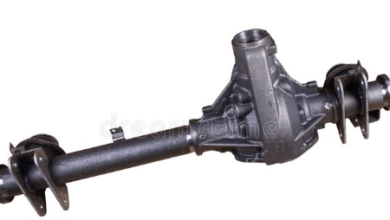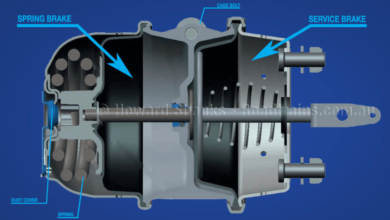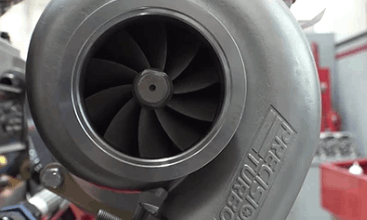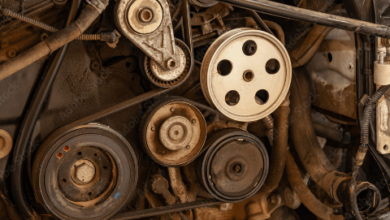Timing Belt Tensioner – Use, Types and Troubleshoot
In a car engine, there are different parts available to make different duties in the engine. Even the most basic parts have very important duties. One of these parts is the timing belt tensioner applications. Here you can find detailed information about the timing belt tensioner systems.
What is Timing Belt Tensioner?
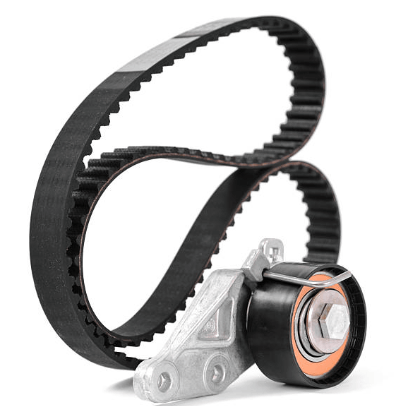
As you understand from its name, they are the systems that we can adjust and regulate the timing belt tension in general. The tension on the timing belt is a very important parameter to consider. Because if the timing belt is loose, it will not turn the other components correctly. Slippings may take place and it will deteriorate the engine performance.
Also if the tension is very hard, it can cause damage to pulleys and other components. And also it can be damaged because of the excessive stress on it.
So adjustment of the belt tension is very important with the timing belt tensioner.
How Does it Work?
The working principle of the timing belt tensioner is very simple. The timing belt tensioner has a spring system that forces the pulley so that the timing belt can pass on it. This spring provides a specific amount same force on the timing belt.
While long periods of use of the timing belt, it can get loose. To compensate for this loosening, the timing belt tensioner mechanism applies a force on it. And even the belt loosens, this force maintains the correct tension on the timing belt. And this provides the correct application on the engine.
Types of Timing Belt Tensioners
In general, there are two types of timing belt tensioner applications. These types are;
- Hydraulic system: In a hydraulic tensioner, there is an oil system that applies pressure on the tensioner. This force is a specific force that holds the timing belt at a specific tension rate.
- Mechanical system: As we explained above, mechanical applications are very common in timing belt tensioner applications. They have a spring system that holds the tension at a specific level.
In terms of damping and more smooth tensioner movement, the hydraulic timing belt tensioner applications provide much better performance. And in high loads and vibrations, the hydraulic applications are generally better. The downside of the hydraulic tensioner is, they take up much more space inside the engine.
Also, the mechanical timing belt tensioner applications are generally simpler systems. Instead of hydraulic applications, they consist a very basic spring load system that provides the required amount of tension.
Symptoms of Bad Timing Belt Tensioner
There are different symptoms of the bad timing belt tensioner system that your car has. You need to consider these important symptoms and take important precautions.
- Strange noises: The rattling and squeaking sounds can be a common problem if the timing belt tensioner has a problem. Because the tension of the belt is not at the required level.
- Bad engine performance: Also you can have a bad engine performance. Because the main duty of the timing belt is to provide good alignment of the crankshaft and camshaft. And if there will be a slip, the engine performance will be affected in a bad way. And also you can have a problem starting the engine.
- Acceleration problems: This is related thing to bad engine performance in general. With the decreasing engine performance, you may not get the required acceleration from your car.
Causes and Solutions of Problems
The general causes for the bad timing belt tensioner can be like below;
- Wear and tear: These are the most common reasons. The pulley mechanism or the spring mechanism can be damaged or torn. In this case, changing the tensioner can be the solution.
- Dirt and dust: Dirt and dust accumulation can cause some issues. It can affect the performance of the tensioner. Cleaning it and preventing clogs and debris may solve the problem in general.
- Oil leaks: If you are using a hydraulic application, you may see hydraulic oil leaks from the system. This means, there is a problem with the seals and you need to change it with a new system.
So, as you understand above, the general solutions are cleaning and changing the part with a new application.
Prices of Replacement
Different factors affect the timing belt tensioner replacement prices in general. The model and the brand of the vehicle is generally the most important point to consider.
But if we need to give a price range, the replacement will cost somewhere between $200-$750. This price includes the expertise and labor costs also.
The tensioner application itself is probably not high in price. But the replacement requires very detailed expertise in general. So, the labor costs are generally higher than the price of the system in general.
Replacement Tips
First of all, replacement of the tensioners is not a DIY thing that you can do by yourself with average tools and average information about the car mechanics. So, you need to bring your car to a service for a replacement. But we can give you some tips about the replacement;
- You will need a socket set, torque wrench, belt tension gauge, and a new timing belt kit.
- You need to remove the timing belt. To do it, you need to loosen the. Once you loosen the tensioner, removing the timing belt is very simple.
- You need to remove the old tensioner by removing the bolts that attach to the system. After that, place the new tensioner. Attach the fasteners well.
- You need to install the timing belt in the place again. Be sure that it rotates around all the correct pulleys. Use the belt tension gauge to find the correct tension. Be sure that all systems are properly aligned.
- After that, test the engine and see if it is working properly and if the problems are solved.
Conclusion
So, belt tensioner applications can be very simple systems. But you need to consider different kinds of important things in general. We explained nearly all the important points about this part. And you know how to apply a correct solution to your problem.
If you have additional comments or questions about the timing belt tensioners, please leave them below.
Check the other related topics about the engine parts;
